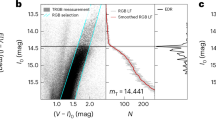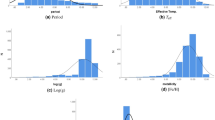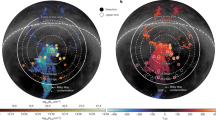Abstract
In the era of precision cosmology, it is essential to determine the Hubble constant empirically with an accuracy of one per cent or better1. At present, the uncertainty on this constant is dominated by the uncertainty in the calibration of the Cepheid period–luminosity relationship2,3 (also known as the Leavitt law). The Large Magellanic Cloud has traditionally served as the best galaxy with which to calibrate Cepheid period–luminosity relations, and as a result has become the best anchor point for the cosmic distance scale4,5. Eclipsing binary systems composed of late-type stars offer the most precise and accurate way to measure the distance to the Large Magellanic Cloud. Currently the limit of the precision attainable with this technique is about two per cent, and is set by the precision of the existing calibrations of the surface brightness–colour relation5,6. Here we report a calibration of the surface brightness–colour relation with a precision of 0.8 per cent. We use this calibration to determine a geometrical distance to the Large Magellanic Cloud that is precise to 1 per cent based on 20 eclipsing binary systems. The final distance is 49.59 ± 0.09 (statistical) ± 0.54 (systematic) kiloparsecs.
This is a preview of subscription content, access via your institution
Access options
Access Nature and 54 other Nature Portfolio journals
Get Nature+, our best-value online-access subscription
$29.99 / 30 days
cancel any time
Subscribe to this journal
Receive 51 print issues and online access
$199.00 per year
only $3.90 per issue
Buy this article
- Purchase on Springer Link
- Instant access to full article PDF
Prices may be subject to local taxes which are calculated during checkout



Similar content being viewed by others
Code availability
We do not provide any code because we used only classical tools such as the IRAF, Daophot and Wilson–Devinney code, and they are publicly available.
Data availability
All data are available upon request from G.P.
References
Komatsu, E. et al. Seven-year Wilkinson Microwave Anisotropy Probe (WMAP) observations: cosmological interpretation. Astrophys. J. Suppl. Ser. 192, 18–65 (2011).
Riess, A. et al. New parallaxes of galactic Cepheids from spatially scanning the Hubble Space Telescope: implications for the Hubble constant. Astrophys. J. 855, 136–149 (2018).
Freedman, W. L. & Madore, B. F. The Hubble constant. Annu. Rev. Astron. Astrophys. 48, 673–710 (2010).
Walker, A. The Large Magellanic Cloud and the distance scale. Astrophys. Space Sci. 341, 43–49 (2012).
Pietrzyński, G. et al. An eclipsing-binary distance to the Large Magellanic Cloud accurate to two per cent. Nature 495, 76–79 (2013).
Di Benedetto, G. P. Predicting accurate stellar angular diameters by the near-infrared surface brightness technique. Mon. Not. R. Astron. Soc. 357, 174–190 (2005).
Laney, C. D., Joner, M. D. & Pietrzyński, G. A new Large Magellanic Cloud K-band distance from precision measurements of nearby red clump stars. Mon. Not. R. Astron. Soc. 419, 1637–1641 (2012).
Gallenne, A. et al. Fundamental properties of red-clump stars from long-baseline interferometry. Astron. Astrophys. 616, A68 (2018).
Mermilliod, J. C., Mermilliod, M. & Hauck, B. The General Catalogue of Photometric Data (GCPD). II. Astron. Astrophys. Suppl. Ser. 124, 349–352 (1997).
Graczyk, D. et al. The Optical Gravitational Lensing Experiment. The OGLE-III catalog of variable stars. XII. Eclipsing binary stars in the Large Magellanic Cloud. Acta Astron. 61, 103–122 (2011).
Soszynski, I. et al. Concluding Henrietta Leavitt’s work on classical Cepheids in the Magellanic system and other updates of the OGLE collection of variable stars. Acta Astron. 67, 103–113 (2017).
Gieren, W. et al. Measuring improved distances to nearby galaxies: the Araucaria project. Messenger 121, 23–28 (2005).
Graczyk, D. et al. The late-type eclipsing binaries in the Large Magellanic Cloud: catalog of fundamental physical parameters. Astrophys. J. 860, 1–30 (2018).
van der Marel, R. P., Alves, D. R., Hardy, E. & Suntzeff, N. B. New understanding of Large Magellanic Cloud structure, dynamics, and orbit from carbon star kinematics. Astron. J. 124, 2639–2663 (2002).
van der Marel, R. P. & Kallivayalil, N. Third-epoch Magellanic Cloud proper motions. II. The Large Magellanic Cloud rotation field in three dimensions. Astrophys. J. 781, 121–141 (2014).
Haschke, R., Grebel, E. K. & Duffau, S. Three-dimensional maps of the Magellanic Clouds using RR Lyrae stars and Cepheids. I. The Large Magellanic Cloud. Astron. J. 144, 106–119 (2012).
Thompson, I. B. et al. Cluster AgeS experiment: the age and distance of the globular cluster ω Centauri determined from observations of the eclipsing binary OGLEGC 17. Astron. J. 121, 3089–3099 (2001).
Mazzarella, J. M. NED for a new era. Astron. Soc. Pacif. Conf. 376, 153–162 (2007).
Persson, S. E. et al. New Cepheid period-luminosity relations for the Large Magellanic Cloud: 92 near-infrared light curves. Astron. J. 128, 2239–2264 (2004).
Perryman, M. A. C. et al. The Hipparcos and Tycho Catalogues (SP-1200, ESA, Noordwijk, 1998).
Bessel, M. S. The Hipparcos and Tycho photometric system passbands. Publ. Astron. Soc. Pacif. 112, 961–965 (2000).
Laney, C. D. & Stobie, R. S. JHKL observations of galactic Cepheids. Astron. Astrophys. Suppl. Ser. 93, 93–120 (1992).
Glass, I. S. Some basics of JHKLM photometry. Ir. Astron. J. 17, 1–10 (1985).
Schlegel, D. J., Finkbeiner, D. P. & Davis, M. Maps of dust infrared emission for use in estimation of reddening and cosmic microwave background radiation foregrounds. Astrophys. J. 500, 525–553 (1998).
Schlafly, E. F. & Finkbeiner, D. P. Measuring reddening with Sloan Digital Sky Survey stellar spectra and recalibrating SFD. Astrophys. J. 737, 103–116 (2011).
Suchomska, K. et al. The Araucaria Project: accurate stellar parameters and distance to evolved eclipsing binary ASAS J180057-2333.8 in Sagittarius Arm. Mon. Not. R. Astron. Soc. 451, 651–659 (2015).
Flower, P. J. Transformations from theoretical Hertzsprung-Russell diagrams to color-magnitude diagrams: effective temperatures, B-V colors, and bolometric corrections. Astrophys. J. 469, 355–365 (1996).
Worthey, G. & Lee, H. An empirical UBV RI JHK color-temperature calibration for stars. Astrophys. J. Suppl. Ser. 193, 1–11 (2011).
Alonso, A., Arribas, S. & Martinez-Roger, C. The effective temperature scale of giant stars (F0-K5). II. Empirical calibration of T eff versus colours and [Fe/H]. Astron. Astrophys. Suppl. Ser. 140, 261–277 (1999).
Castelli, F. & Kurucz, R. L. New grids of ATLAS9 model atmospheres. In Modelling of Stellar Atmospheres 17–21 (IAU Symp. 210, Astron. Soc. Pacif., Uppsala, 2003).
Gaia Collaboration. Gaia Data Release 1. Testing parallaxes with local Cepheids and RR Lyrae stars. Astron. Astrophys. 605, A79 (2017).
Wright, E. L. et al. The Wide-field Infrared Survey Explorer (WISE): mission description and initial on-orbit performance. Astron. J. 140, 1868–1881 (2010).
Gallenne, A. et al. Observational calibration of the projection factor of Cepheids. IV. Period-projection factor relation of Galactic and Magellanic Cloud Cepheids. Astron. Astrophys. 608, A18 (2017).
Graczyk, D. et al. The Araucaria Project. The distance to the Small Magellanic Cloud from late-type eclipsing binaries. Astrophys. J. 780, 59 (2014).
Torres, G., Claret, A. & Young, P. A. Binary orbit, physical properties, and evolutionary state of Capella (α Aurigae). Astrophys. J. 700, 1349–1381 (2009).
Gallenne, A. et al. The Araucaria Project: high-precision orbital parallax and masses of the eclipsing binary TZ Fornacis. Astron. Astrophys. 586, A35 (2016).
Andersen, J. Absolute dimensions of eclipsing binaries. XVII — TZ Fornacis: stellar and tidal evolution in a binary with a fully-fledged red giant. Astron. Astrophys. 246, 99–117 (1991).
Gallenne, A. et al. A geometrical 1% distance to the short-period binary Cepheid V1334 Cygni. Astrophys. J. 867, 121–130 (2018).
Lindegren, L. et al. Gaia Data Release 2. The astrometric solution. Astron. Astrophys. 616, A2 (2018).
Arenou, F. et al. Gaia Data Release 2. Catalogue validation. Astron. Astrophys. 616, A17 (2018).
Graczyk, D. et al. Testing systematics of Gaia DR2 parallaxes with empirical surface brightness relations applied to eclipsing binaries. Preprint at https://arxiv.org/abs/1902.00589 (2019).
Johnson, H. L., Mitchell, R. I., Iriarte, B. & Wisniewski, W. Z. Ubvrijkl photometry of the bright stars. Commun. Lunar Planet. Lab. 4, 99–110 (1966).
Wild, P. A. T. UBV photometry of 137 stars in an area near the south galactic pole. Mon. Not. Astron. Soc. S. Afr. 28, 123–130 (1969).
Pfleiderer, J., Dachs, J. & Haug, U. Z. Lichtelektrische UBV-Photometrie von Standardsternen und in Vier Sternenfelder am Aequator. Z. Astrophys. 64, 116–138 (1966).
Appenzeller, I. Polarimetrische, Photometrische und Spectroskopische Beobachtungen von Sternen im Cygnus und Orion. Z. Astrophys. 64, 269–295 (1966).
Breger, M. UBV and narrow-band uvby photometry of bright stars. Astron. J. 73, 84–85 (1968).
Cousins, A. W. J. Revised zero points and UBV photometry in the Harvard E and F regions. Mem. R. Astron. Soc. 77, 223–236 (1973).
Feinstein, A. Photoelectric observations of southern late-type stars. Inform. Bull. South. Hem. 8, 30–35 (1966).
Cousins, A. W. J. UBV photometry of E region standard stars of intermediate brightness. S. Afr. Astron. Obs. Circ. No. 7, 36–46 (1983).
IAU Supplementary Standard Stars for V and B-V 251 (IAU Trans. IIa, 1961).
Cousins, A. W. J. Photometric data for stars in the equatorial zone (first list). Mon. Not. Astron. Soc. S. Afr. 21, 20–24 (1962).
Cousins, A. W. J. & Stoy, R. H. Photoelectric magnitudes and colours of southern stars. R. Obs. Bull. 64, 103 (1962)
Elvius, T. & Lynga, G. Three-colour photometry of 43 stars in Kapteyn’s selected areas at southern galactic latitudes. Ark. Astron. 3, 467–473 (1965).
Cousins, A. W. J. Photometric data for stars in the equatorial zone (third list). Mon. Not. Astron. Soc. S. Afr. 22, 12–17 (1963).
Przybylski, A. & Kennedy, P. M. Radial velocities and three-colour photometry of 166 southern stars. Mon. Not. R. Astron. Soc. 131, 95–104 (1965).
Argue, A. N. UBV photometry of 550 F, G and K type stars. Mon. Not. R. Astron. Soc. 133, 475–493 (1966).
Cousins, A. W. J. Photometric data for stars in the equatorial zone (fourth list). Mon. Not. Astron. Soc. S. Afr. 22, 58–62 (1963).
Corben, P. M. Photoelectric magnitudes and colours for bright southern stars. Mon. Not. Astron. Soc. S. Afr. 25, 44–51 (1966).
Corben, P. M. Photoelectric magnitudes and colours for bright southern stars. Mon. Not. Astron. Soc. S. Afr. 30, 37–50 (1971).
Corben, P. M. & Stoy, R. H. Photoelectric magnitudes and colours for bright southern stars. Mon. Not. Astron. Soc. S. Afr. 27, 11–16 (1968).
Cousins, A. W. J. & Stoy, R. H. Standard magnitudes in the E regions. R. Obs. Bull. 49, 3–9 (1962)
Cousins, A. W. J. & Stoy, R. H. Photoelectric magnitudes and colours of southern stars. R. Obs. Bull. 64, 103–109 (1962)
Cousins, A. W. J., Lake, R. & Stoy, R. H. Photoelectric magnitudes and colours of southern stars. R. Obs. Bull. No. 121, 1–7 (1966)
Evans, D. S. Fundamental data for southern stars. R. Obs. Bull. 110, 185–191 (1966)
Irwin, J. B. Southern Cepheid photometry. Astrophys. J. Suppl. Ser. 6, 253–302 (1961).
Lake, R. Photoelectric magnitudes and colours for 168 southern stars. Mon. Not. Astron. Soc. S. Afr. 21, 56–60 (1962).
Lake, R. Photoelectric magnitudes and colours for 100 southern stars. Mon. Not. Astron. Soc. S. Afr. 21, 191 (1962).
Lake, R. Photoelectric magnitudes and colours for 100 southern stars. Mon. Not. Astron. Soc. S. Afr. 23, 136–139 (1964).
Lake, R. Photoelectric magnitudes and colours for bright southern stars. Mon. Not. Astron. Soc. S. Afr. 24, 41–50 (1965).
Stoy, R. H. Photoelectric three colour magnitudes for 354 southern stars. Mon. Not. Astron. Soc. S. Afr. 22, 157 (1963).
Stoy, R. H. Photoelectric magnitudes and colours for bright southern stars. Mon. Not. Astron. Soc. S. Afr. 27, 119–128 (1968).
Cousins, A. W. J. Cape ubv magnitudes and colours of south circumpolar stars. S. Afr. Astron. Obs. Circ. No. 1, 51–58 (1977).
Johnson, H. L., Mitchell, R. I., Iriarte, B. & Wisniewski, W. Z. UBVRIJKL photometry of the bright stars. Lunar Planet. Lab. 63, 99–110 (1966).
Mendoza, E. E. Bvri photometry of 46 southern bright stars. Bol. Obs. Tonantzintla Tacubaya 5, 57–58 (1969).
Mermilliod, J. C. & Mermilliod, M. Catalogue Of Eggen’s UBV Data (1986).
Jennens, P. A. & Helfer, H. A new photometric metal abundance and luminosity calibration for field G and K giants. Mon. Not. R. Astron. Soc. 172, 667–679 (1975).
Southworth, J. Homogeneous studies of transiting extrasolar planets – I. Light-curve analyses. Mon. Not. R. Astron. Soc. 386, 1644–1666 (2008).
Popper, D. M. Stellar masses. Annu. Rev. Astron. Astrophys. 18, 115–164 (1980).
Wilson, R. E. & Devinney, E. J. Realization of accurate close-binary light curves: application to MR Cygni. Astrophys. J. 166, 605–620 (1971).
Jacyszyn-Dobrzeniecka, A. M. et al. OGLE-ing the Magellanic System: three-dimensional structure of the clouds and the bridge using classical Cepheids. Acta Astron. 66, 149–196 (2016).
Acknowledgements
The research leading to these results has received funding from the European Research Council (ERC) under the European Union’s Horizon 2020 research and innovation programme (grant agreement no. 695099). We acknowledge support from the IdP II 2015 0002 64 and DIR/WK/2018/09 grants of the Polish Ministry of Science and Higher Education. We also gratefully acknowledge financial support for this work from the BASAL Centro de Astrofisica y Tecnologias Afines (CATA, AFB-170002), and from the Millennium Institute for Astrophysics (MAS) of the Iniciativa Milenio del Ministerio de Economía, Fomento y Turismo de Chile, project IC120009. We also acknowledge support from the Polish National Science Center grant MAESTRO DEC-2012/06/A/ST9/00269. We acknowledge the support of the French Agence Nationale de la Recherche (ANR), under grant ANR-15-CE31-0012-01 (project UnlockCepheids). S.V. gratefully acknowledges the support provided by Fondecyt reg. no. 1170518. This work is based on observations made with ESO telescopes under programmes 092.D-0297, 094.D-0074, 098.D-0263(A,B), 097.D-0400(A), 097.D-0150(A), 097.D-0151(A) and CNTAC programmes CN2016B-38, CN2016A-22, CN2015B-2 and CN2015A-18. This research was supported by the Munich Institute for Astro- and Particle Physics (MIAPP) of the DFG cluster of excellence “Origin and Structure of the Universe”.
Author information
Authors and Affiliations
Contributions
G.P., photometric and spectroscopic observations, data analysis. D.G., spectroscopic observations, modelling, data analysis. A.G., interferometric observations, data reduction and analysis. W.G., observations and data analysis. I.B.T., observations, RV determination, data analysis. B.P., spectroscopic observations and reductions, RV measurements. P. Karczmarek, M.G., M.T., B.Z., P.W., Z.K., P. Konorski, observations and data reductions. S.V., analysis of the spectroscopic data. N.N., P. Kervella, F.B., R.P.K., J.S., R.S., K.S. and W.N., data analysis, discussion of results. G.P. and W.G. worked jointly to draft the manuscript with all authors reviewing and contributing to its final form.
Corresponding author
Ethics declarations
Competing interests
The authors declare no competing interests.
Additional information
Publisher’s note: Springer Nature remains neutral with regard to jurisdictional claims in published maps and institutional affiliations.
Extended data figures and tables
Extended Data Fig. 1 Comparison of our relation with the relation of Di Benedetto obtained for giant stars6.
Top panel, comparison of relations: data points show our results, with the fitted line shown in blue. The blue shaded area represents our obtained r.m.s. scatter of 0.018 mag. The green line is from ref. 6. Very good agreement is demonstrated. Both SV and (V − K)0 are in magnitudes. SV physically corresponds to the V band magnitude of a red giant star whose angular diameter is 1 mas. The error bars correspond to 1σ errors. Bottom panel, observed minus calculated values.
Extended Data Fig. 2 Observed minus calculated surface brightness versus metallicity6, [Fe/H].
In a relatively large range of metallicities (about 1 dex) no correlation is found. A formal linear fit gives O − C = 0.0009[Fe/H] – 0.002 dex with coefficient of determination R2 = 0.0001.
Extended Data Fig. 3 Example of Monte Carlo simulations for one of our objects, ECL-12669.
We computed 10,000 models with the JKTEBOP code77 from which we obtained statistical uncertainties on the radii R1 and R2, the orbital inclination i, the phase shift φ, the surface brightness ratio j21, radial velocity semi-amplitudes K1 and K2, and the systemic velocities γ1 and γ2. For every model we computed the distance modulus converting j21 into temperature ratio T2/T1 by using Popper’s calibration78 and our original solution with the Wilson–Devinney code79. We plot the number of calculated models versus distance modulus (m − M). The dashed line is the best fitted Gaussian and the blue line is the distance determined for this object. The intrinsic (V − K)0 colours used to estimate the angular diameters of the components were computed using a temperature–colour calibration28.
Extended Data Fig. 4 Error estimate of distance modulus of the LMC from Monte Carlo simulations.
For each eclipsing binary we calculated random 20,000 distance moduli with Gaussian distribution assuming μ = m − Mmean and σ = σmean from Table 1. Then we fitted 20,000 planes with the linear least-squares method for every set of distance moduli using as free parameters inclination of the disk plane, i, the position of the nodes, Θ, and the distance to the centre of the LMC, d. Apparent positions were converted into the three-dimensional Cartesian positions80. We plot the number of calculated models versus distance modulus (m − M). The dashed line is the best fitted Gaussian and the blue line is the distance of the LMC.
Rights and permissions
About this article
Cite this article
Pietrzyński, G., Graczyk, D., Gallenne, A. et al. A distance to the Large Magellanic Cloud that is precise to one per cent. Nature 567, 200–203 (2019). https://doi.org/10.1038/s41586-019-0999-4
Received:
Accepted:
Published:
Issue Date:
DOI: https://doi.org/10.1038/s41586-019-0999-4
This article is cited by
-
A probable Keplerian disk feeding an optically revealed massive young star
Nature (2024)
-
Sub-per-cent determination of the brightness at the tip of the red giant branch in the Magellanic Clouds
Nature Astronomy (2023)
-
The use of double-mode RR Lyrae stars as robust distance and metallicity indicators
Nature Astronomy (2023)
-
A helium-burning white dwarf binary as a supersoft X-ray source
Nature (2023)
-
Cosmological distances and Hubble tension in Einstein–Cartan theory
General Relativity and Gravitation (2023)
Comments
By submitting a comment you agree to abide by our Terms and Community Guidelines. If you find something abusive or that does not comply with our terms or guidelines please flag it as inappropriate.



